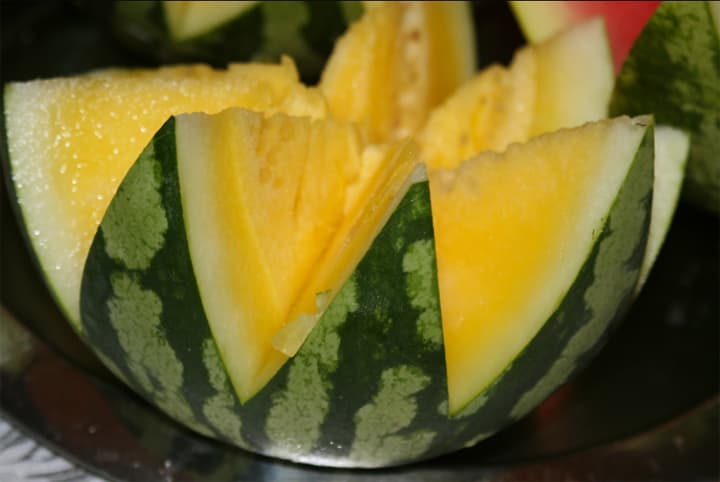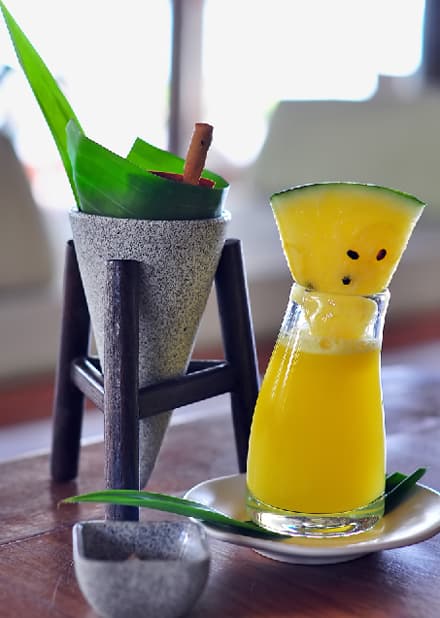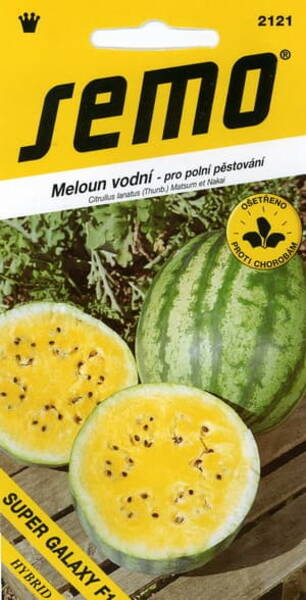For growing in open ground.
* Greenhouse watermelon.
This technology can be successfully applied in all regions where melons are not a traditional crop, including Estonia.
It would seem that the northern summer is not suitable for growing these plants, because watermelons are just as heat-loving as melons.
However, it is also entirely possible to grow sweet watermelons here, albeit only in a greenhouse, by choosing very early varieties and following certain agricultural practices.
Of course, we are talking about only a few plants, since greenhouse space is limited.

WILL FINISH COLD-RESISTANT HYBRIDS.
There is no point in using seeds from Central Asian watermelons for sowing - in our conditions you won't get any fruit from them.
For regions with harsh climates, not just any seeds are suitable, but only those of special varieties and hybrids of cold-resistant watermelons:
Portioned red F 1, Gift to the North F 1, Crimson sweet F 1, Moscow region Charleston F 1, Pink champagne F 1,
Earthling, Gift of the Sun, Sugar Baby, Ultra-Early.
All of them are distinguished by their cold resistance, begin to bear fruit early (approximately on the 70-75th day) and form sweet fruits even in cool climates.
The size of the fruits depends on the hybrid variety - they can reach 3-5 kg or even 9-12 kg.
But this is ideal - in our case the size of the formed fruits turns out to be smaller, although the watermelons themselves still taste very good.
SOWING - B PEAT POTS.
Seeds for seedlings are sown around the 2nd ten days of April.
To increase cold resistance and endurance of plants to unfavorable conditions, it is recommended to pre-sow seeds soaking in a growth stimulator (for example, Epine ).
It is advisable to grow watermelons using grafting technology, i.e. grafted onto pumpkins (best of all - onto fig-leaved pumpkin ).
In this case, the plants will be stronger and healthier (since they are not affected by soil pathogens), the harvest will be obtained earlier, and the watermelons themselves will grow much larger.
Although own-root watermelons are also successfully grown, it is not possible to obtain fruits as large as those promised by seed producers.
Since all melon crops do not tolerate damage to the root system very well, the seeds should be sown immediately in separate pots.
If you plan to graft watermelons, then additionally sow a pumpkin seed in the same pot.
In this case, the scion seeds are usually sown earlier (usually 2-3 days ahead) so that the watermelon seedlings emerge ahead of the pumpkin seedlings.
The soil for seedlings is prepared from equal parts of compost and ordinary garden soil.
For 1 bucket of soil substrate add 1 tbsp of nitrogen fertilizers (for example, urea ), 1-2 tbsp of phosphorus (for example, superphosphate ) and 1 tbsp of potassium (for example, potassium sulfate ).
LET'S TAKE CARE OF THE SEEDLINGS.
The optimal temperature for germination of watermelon seeds is +30°C (under these conditions they germinate within 48 hours).
A higher temperature is undesirable (the seeds may germinate later or die altogether), as is a lower one,
because at temperatures below +15°C, watermelon seedlings practically do not develop, and at +10°C, photosynthesis processes in plants stop and young plants may die.
In the future, daytime temperatures should be reduced to +22+25°C, and nighttime temperatures to approximately +19+20°C.
Watermelon is a short-day plant, so you should not increase the length of daylight hours to more than 12 hours when growing seedlings.
because this will lead to a later setting of flowers and slow down the fruiting of plants.
Watermelons, like melons, are very light-loving, so trays with seedlings should be placed in the brightest place.
Since in an apartment, even with supplementary lighting, the level of illumination is insufficient, it is advisable to spray the plants with such stimulants weekly,
like Epin and Zircon .
Water the seedlings only with warm water—as needed and very sparingly. Overwatering is unacceptable, as it leads to root rot.
When 3-4 true leaves appear, begin weekly fertilizing with complex fertilizers containing a full range of macro- and microelements.
If the plants were supposed to be grafted, then the grafting is best done approximately 2-3 days after the pumpkin seedlings appear.
- at this moment, the first true leaf should appear on both the rootstock and the scion.
The easiest way to graft is by "approximation grafting." In this case, a 2-cm strip of skin is removed from the watermelon and pumpkin plants along the stem.
The stems are brought together in the corresponding parts and the grafting site is bandaged with a strip of covering material.
PLANTING - ON WARM BEDS.
In Estonia, transplanting seedlings into a greenhouse is done around the end of May. By this time, the seedlings should be 25-30 days old.
and the greenhouse soil must be fully prepared and well warmed, since watermelon, like all melons, is very demanding of soil temperature
(optimal substrate temperature is +20+24°C).
It should be noted that grafted watermelons are less demanding in this regard and can better withstand spring cold snaps.
Watermelon prefers very fertile, structured soils. It is believed that watermelon is less demanding of fertility than cantaloupe.
However, in our country it produces high yields only on well-cultivated, warm, aerated soils.
with a neutral reaction and a deep root zone (at least 30 cm). Therefore, greenhouse beds should be high and biofuel-fired.
The technology for planting seedlings is traditional: the plants are watered, carefully removed from the pots and planted without burying the root collar
(due to the susceptibility of plants to root rot) in prepared holes.
Usually, 5 ungrafted or 3 grafted plants are placed per 1 m2, since the latter form more powerful bushes.
After planting, the surface of the beds is mulched with fallen leaves, scattering the mulch so that it does not come into contact with the stems of the plants,
Otherwise, with high humidity, this can lead to root rot.
At the same time, it is not advisable to refuse mulch, since it ensures air permeability and looseness of the soil.

Five signs of a nitrate watermelon :
* Tap the watermelon - it feels like you're hitting a deflated ball...
* the cut is smooth and even glossy in appearance, although it should glow with sugar grains...
* If you crush the pulp into a glass of water, the water will turn pink or red; a healthy watermelon will simply make the liquid cloudy...
* the flesh is pale with thick veins...
* If a watermelon doesn't crack when squeezed, but looks ripe, it means it ripened with some help from someone else...












